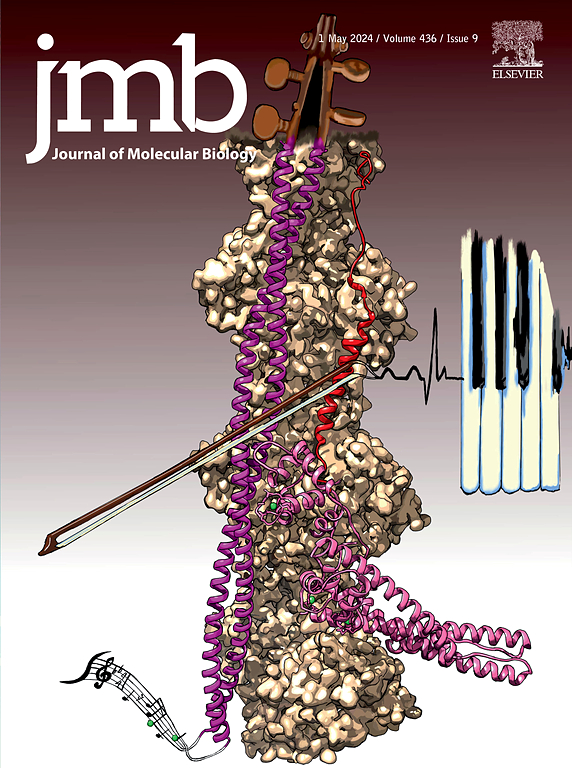Properties Governing Native State Entanglements and Relationships to Protein Function
IF 4.7
2区 生物学
Q1 BIOCHEMISTRY & MOLECULAR BIOLOGY
引用次数: 0
Abstract
Non-covalent lasso entanglements are structural motifs found in a majority of globular proteins, and their misfolding has been linked to a range of biological consequences. Here, we characterize these motifs’ structural and physicochemical properties, sequence biases, functional site correlations, and universal features across E. coli, S. cerevisiae, and H. sapiens. We find that the crossing residues, which pierce the plane of the entanglement loop, are 11-times more likely to be a β-strand than an α-helix or random coil, and that around this position the protein sequence is 2.5-times more likely to be composed of a stretch of all hydrophobic residues (most often Val, Ile, or Phe) compared to other sequence motifs. Functionally, crossing residues are enriched at enzyme active sites in S. cerevisiae and small molecule binding residues across all species to degrees greater than expected by random chance. Metal binding residues are enriched in these entanglements in H. sapiens. Increasing statistical power by pooling together these species data, we find RNA-binding residues are enriched in these entanglement components. On the other hand, there is a spatial depletion of crossing residues at sites involved in protein binding. Using machine learning, we identified eight robust features predictive of these entanglements, achieving AUROC scores of 0.8 across species. These results are significant because they suggest a direct role for components of native entanglements in particular protein functions, as well as identifying strong secondary structure and sequence preferences in native entanglements.

控制天然状态纠缠的特性和与蛋白质功能的关系。
非共价套索缠结是在大多数球状蛋白中发现的结构基序,它们的错误折叠与一系列生物学后果有关。在这里,我们描述了这些基序的结构和物理化学性质、序列偏差、功能位点相关性以及大肠杆菌、葡萄球菌和智人的普遍特征。我们发现穿过缠结环平面的交叉残基是β-链的可能性是α-螺旋或随机线圈的11倍,而在这个位置周围的蛋白质序列是由所有疏水残基(最常见的是Val, Ile或Phe)组成的可能性是其他序列基序的2.5倍。在功能上,酿酒酵母的酶活性位点和所有物种的小分子结合残基的交叉残基富集程度大于随机概率。金属结合残基在智人的这些缠结中富集。通过汇集这些物种的数据,增加了统计能力,我们发现rna结合残基在这些纠缠成分中丰富。另一方面,在参与蛋白质结合的位点存在交叉残基的空间耗竭。利用机器学习,我们确定了8个预测这些缠结的稳健特征,实现了跨物种的AUROC得分为0.8。这些结果具有重要意义,因为它们表明天然缠结的成分在特定蛋白质功能中的直接作用,以及确定天然缠结的强二级结构和序列偏好。
本文章由计算机程序翻译,如有差异,请以英文原文为准。
求助全文
约1分钟内获得全文
求助全文
来源期刊

Journal of Molecular Biology
生物-生化与分子生物学
CiteScore
11.30
自引率
1.80%
发文量
412
审稿时长
28 days
期刊介绍:
Journal of Molecular Biology (JMB) provides high quality, comprehensive and broad coverage in all areas of molecular biology. The journal publishes original scientific research papers that provide mechanistic and functional insights and report a significant advance to the field. The journal encourages the submission of multidisciplinary studies that use complementary experimental and computational approaches to address challenging biological questions.
Research areas include but are not limited to: Biomolecular interactions, signaling networks, systems biology; Cell cycle, cell growth, cell differentiation; Cell death, autophagy; Cell signaling and regulation; Chemical biology; Computational biology, in combination with experimental studies; DNA replication, repair, and recombination; Development, regenerative biology, mechanistic and functional studies of stem cells; Epigenetics, chromatin structure and function; Gene expression; Membrane processes, cell surface proteins and cell-cell interactions; Methodological advances, both experimental and theoretical, including databases; Microbiology, virology, and interactions with the host or environment; Microbiota mechanistic and functional studies; Nuclear organization; Post-translational modifications, proteomics; Processing and function of biologically important macromolecules and complexes; Molecular basis of disease; RNA processing, structure and functions of non-coding RNAs, transcription; Sorting, spatiotemporal organization, trafficking; Structural biology; Synthetic biology; Translation, protein folding, chaperones, protein degradation and quality control.
 求助内容:
求助内容: 应助结果提醒方式:
应助结果提醒方式:


